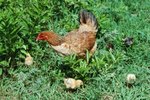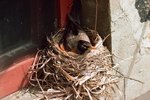Nobody wants lousy chickens. If your chickens suffer from lice infestation, you can take steps to remove them. Since lice spread so easily from bird to bird, if one chicken in your flock appears lousy, treat every bird.
Tiny Lice
Chicken lice are tiny, flat and wingless. No matter the type of poultry mite -- which can vary by region -- they all have mouthparts with which to chew on the host bird. Chicken lice feast on feathers, scales of dry skin and any sores on the bird. Unlike other types of lice, they don't actually suck the chicken's blood per se, only feeding on blood from lesions the bird acquires by other means. You'll also notice the lice eggs, or nits, attached to the lower end of the bird's feathers.
... and Big Problems
Symptoms of chickens with lice are similar to those with mite infestation, so make sure you are dealing with the right parasite. Still, many of the treatments for eradicating both pests overlap. Chickens with lice may go off their feed, lose weight, reduce egg laying, experience feather loss and generally look unthrifty. The parasites might cause some birds to start scratching. Lice infestation most often occurs in autumn and winter. You're most likely to spot lice around the bird's vent. The vent of affected chickens is often quite red.
A Natural Recipe
If you don't like the idea of using pesticides on your flock, pursue natural ways to get rid of or prevent lice. Provide your chickens with food-grade diatomaceous earth for their dust baths. You can also place the substance on their bodies and massage it in. Diatomaceous earth, the fossilized remains of ancient plants, contains sharp edges that pierce the bodies of lice and mites.
Backyard Poultry magazine offers a recipe for lice and mite removal, consisting of the following ingredients mixed in a tub:
- 2 cups of salt
- 2 cups of distilled white vinegar
- 2 cups of gentle liquid soap, such castile
- 5 gallons of warm water
Place each chicken in your flock into the tub for five minutes, with only the head protruding. Rinse the chicken in warm water after the bath, and dry the bird thoroughly with a towel. Repeat the bath two weeks later -- the second bath eradicates the nits.
Chemical Lice Removal
Commercial products for lice removal include carbaryl, marketed under the brand name Sevrin, along with pyrethrins. In addition to applying these dusts within the coop, treat individual birds by putting the powder in a trash bag, then placing the chicken inside -- with the exception of the head. Shake the bag with the chicken enclosed for thorough coating.
Warnings
Wear a face mask to avoid breathing the dust.
Sevrin dust is available in a can so you can shake the powder onto the bird rather than use the bag method. Repeat the treatment for nit removal two weeks later. For severe infestations, your veterinarian can apply the dewormer ivermectin to your birds.
Writer Bio
Jane Meggitt has been a writer for more than 20 years. In addition to reporting for a major newspaper chain, she has been published in "Horse News," "Suburban Classic," "Hoof Beats," "Equine Journal" and other publications. She has a Bachelor of Arts in English from New York University and an Associate of Arts from the American Academy of Dramatics Arts, New York City.




